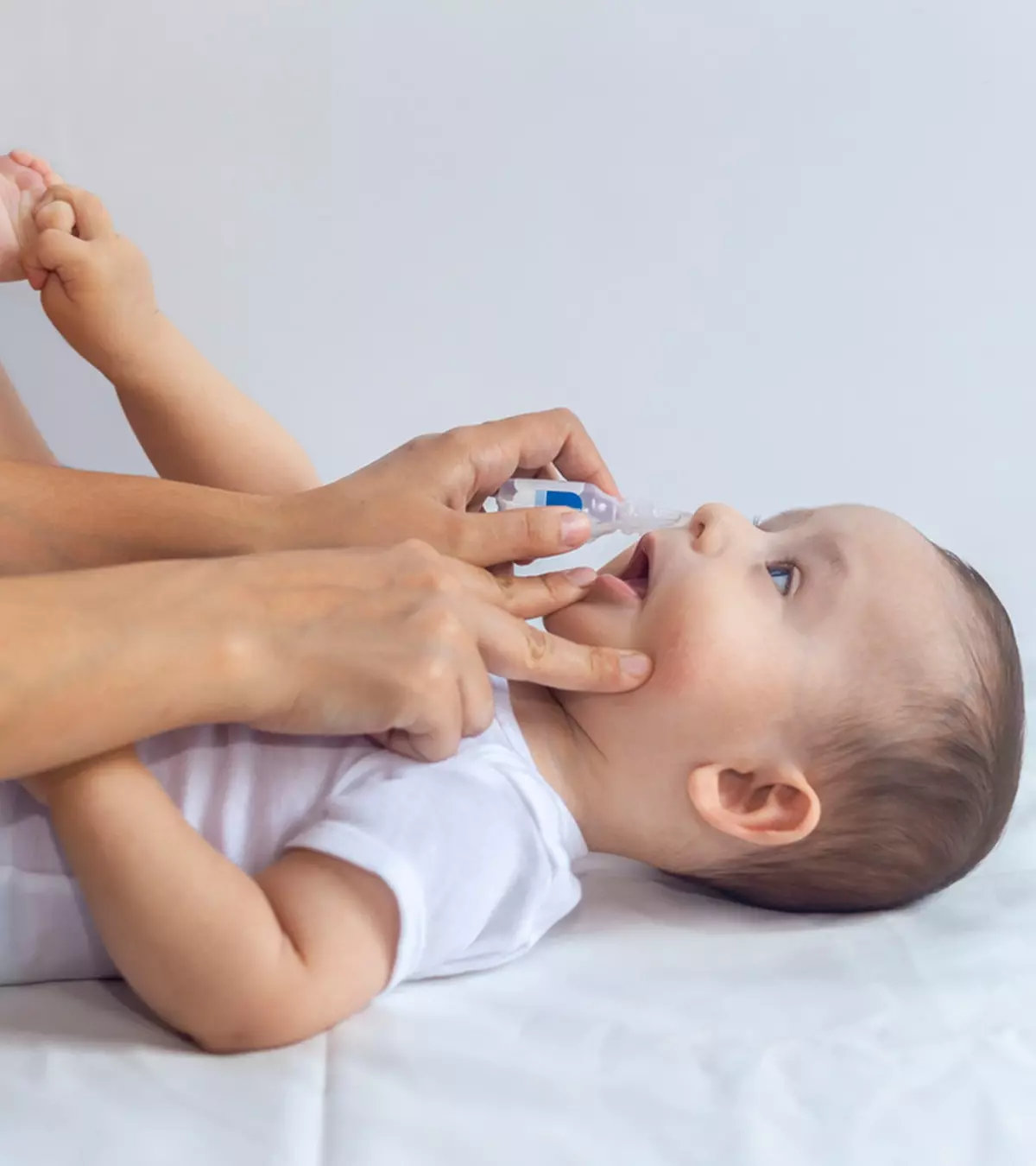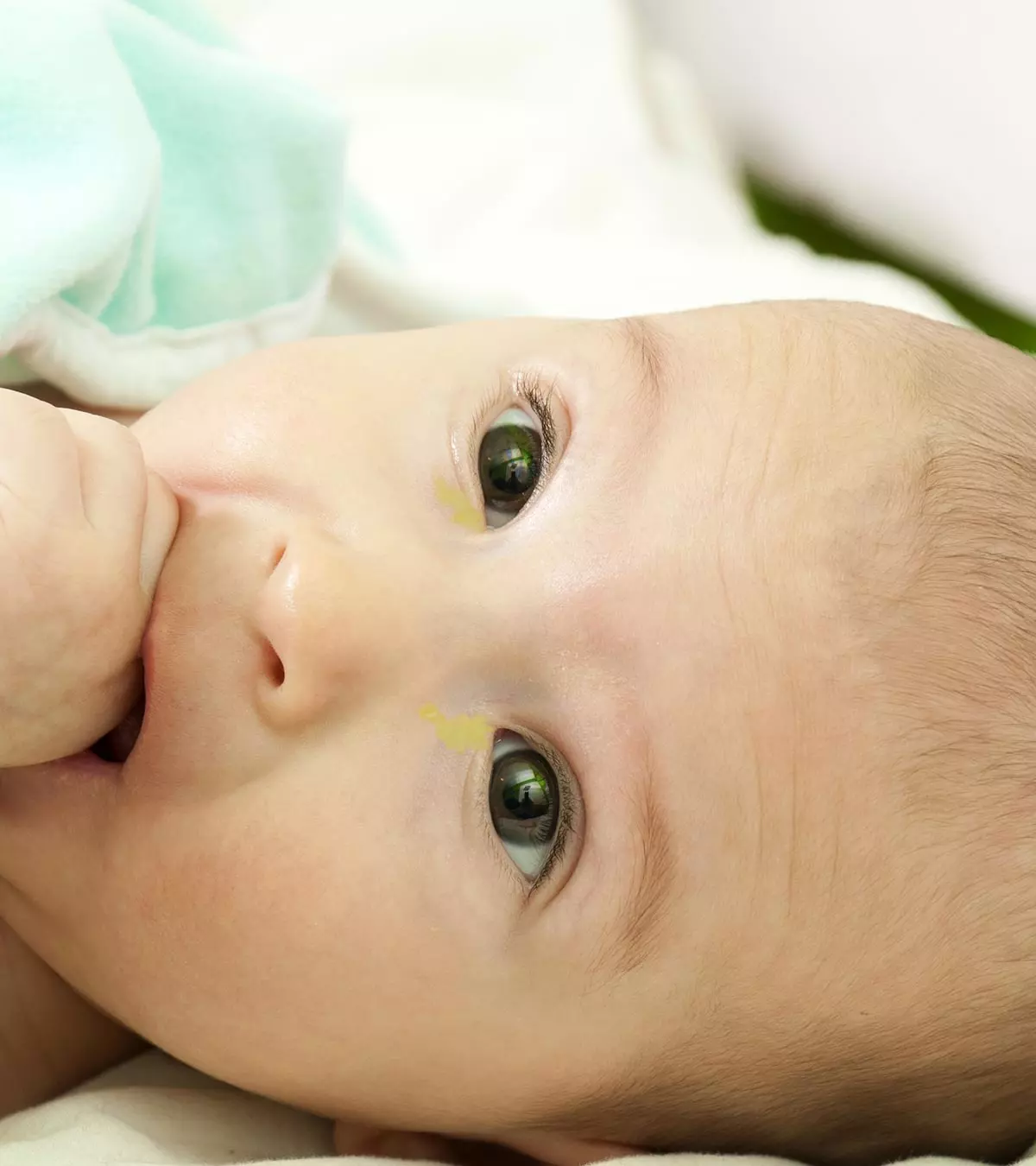
Image: ShutterStock
Grimacing or mouthing in babies is defined as a contact of an object with the baby’s lips, tongue, or mouth (1). According to experts, it is a common behavior that a baby can have an oral fixation during infancy as they put everything in their mouths. Be it their hands, a toy, blanket, or teether, babies fiddle with things and then put them in their mouths. But why do babies grimace? Does grimacing indicate any underlying problem? Keep reading to learn about the mouthing phase in babies and the possible risks that mouthing everything can raise.
Key Pointers
- Babies tend to put everything in their mouths to explore the shape, taste, and texture of objects.
- They also use this technique to soothe their gums during the teething phase.
- Some people believe that this practice may improve immunity and ease the process of transitioning babies to solids.
- Offering appropriate toys or objects to babies can help to discourage babies from putting other items in their mouths.
- To prevent choking and infection, all toys and teethers should be cleaned regularly, and babies must be supervised at all times.
Why Do Babies Put Everything In Their Mouths?
Once babies develop a grip and can hold things, they try to put everything in their mouths to determine the texture, shape, and taste of the item. Their exploration behavior prompts them to use all their sensory exploration techniques to learn more about the things around them. Babies are born with certain reflexes. A reflex is a muscle reaction that happens automatically in response to stimulation. Certain sensations or movements produce specific muscle responses (2). The common reflexes related to mouthing are:
- Rooting reflex: This reflex is seen when the baby’s cheek is stroked. The infant turns towards the side where he/she was stroked and exhibits sucking actions.
- Suck reflex: The baby makes a sucking motion when the area around the mouth is touched.
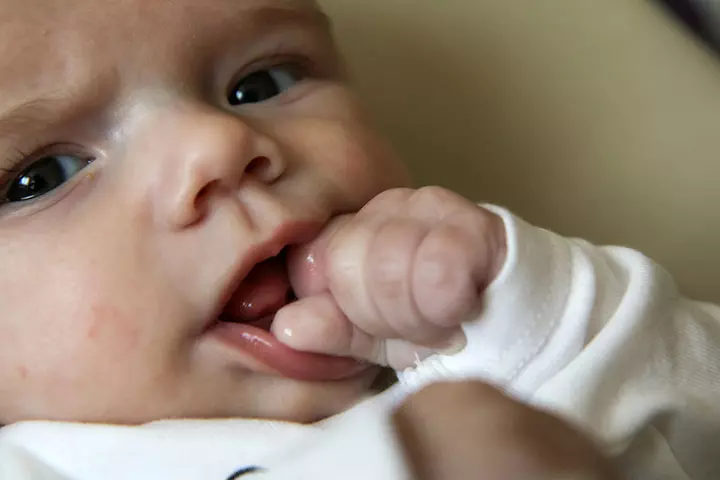
Image: IStock
Rooting and sucking reflexes are a natural phenomenon that causes the baby to put everything in their mouth to facilitate object exploration.
There are some other attributes of mouthing in babies.
- It is believed that mouthing is a natural phenomenon that exercises the mouth’s muscles, thus making them strong for essential actions like eating and speaking. By mouthing, the babies learn to establish a harmonious movement between the lips, tongue, jaws, and cheeks.
- During the baby teeth eruption or the teething phase, babies are seen to put things in their mouths to soothe the sore and irritated gums (3). Drooling due to saliva production is common during this phase. You can buy them safe mouthing toys to soothe the pain they experience during this phase.
- Some studies suggest that mouthing may lead to speech development in babies (1).
- Some people believe that putting everything in their mouths helps develop a baby’s immunity by exposing them to various microorganisms.
- Mouthing is also believed to play a vital role in sensory exploration, allowing babies to learn about their environment and understand the world around them through touch and taste. This behavior is crucial for cognitive and physical development, encouraging curiosity and learning.
- It is also believed that mouthing makes the baby habituated to the feeling of a solid substance in their mouth. It might help in a smooth transition to solid foods.
Here’s what Matea, a mother of two, says about her observations of her son’s mouthing phase: “Our daughter stopped being so much interested in putting everything in her mouth and chewing it after she turned 13 months (maybe cause she already had most of the teeth by that age). But her little brother of 15 months is still very much into exploring many things with his mouth. He’ll take everything that seems tempting from the floor and put it into his mouth – ranging from a snail to various flowers and grass. In the case of the sand from the sandbox, I let him explore; I just gently tell him sand is for playing and not for eating. I guess his natural instinct tells him to put it in his mouth as it helps him tremendously as pain relief from teething (ⅰ).”
Do All Babies Put Things In Their Mouths?
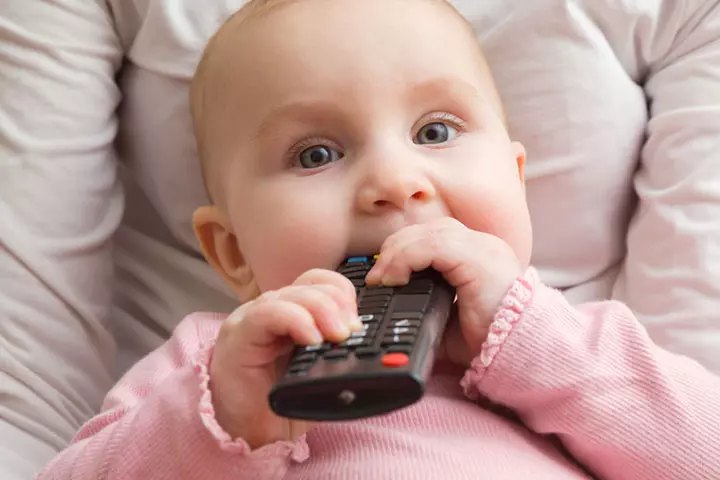
Image: Shutterstock
Most babies have the tendency to place an object in their mouth. The habit is often present at some point during infancy. Most babies outgrow the habit or stop placing specific objects in the mouth as they grow a little older. It is noticed that babies use pacifiers for a longer duration than other objects to put in their mouths (4).
Why Do Babies Put Their Feet In Their Mouths?
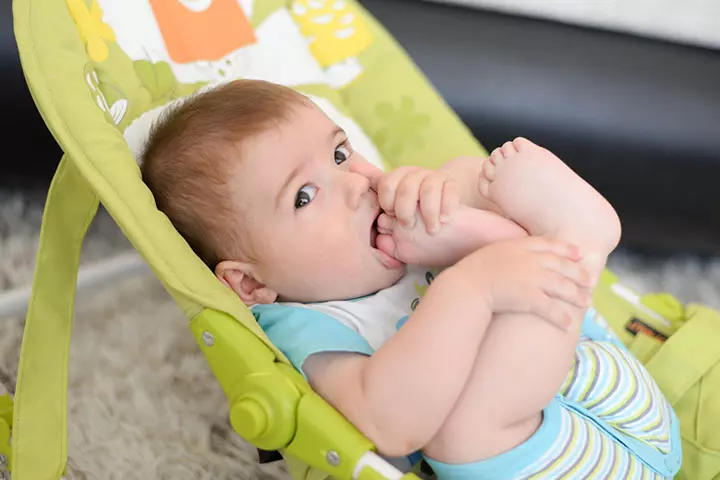
Image: Shutterstock
Babies place feet in their mouth for the same reasons as they put their hands. As babies begin to grow, they develop better control and strength and thus are able to lift their legs and grab them with their hands. The flexibility of a baby’s body allows the feet to reach the mouth easily.
Mouthing helps the little one explore their feet with their mouths. For non-mobile babies, holding toes is like having a toy that is never far away. For some babies, sucking on to the toes might also help soothe them.
When Do Babies Stop Putting Things In Their Mouths?
Usually, babies stop putting things in their mouths by the age of three years. Signs that your baby is outgrowing this habit include increased hand-eye coordination, the ability to communicate more effectively, and a preference for exploring objects through other senses. But in some cases, the habit of baby sucking thumb or putting other objects in their mouths may go beyond four years. They might also develop a habit of thumb or finger sucking. Babies with mouthing habits beyond four years of age might need some corrective measures or habit-breaking appliances (5).
 Quick tip
Quick tipWhat Are The Possible Risks Of Babies Putting Things In Their Mouth?
Although the habit of mouthing in itself is not harmful, it might bring some possible risks along for the babies.
1. Infections

Image: Shutterstock
Babies with a habit of mouthing might put anything and everything in their mouth. It becomes even more difficult to monitor them when they begin to crawl. It exposes the baby to contaminated objects, which increases the risk of bacterial or viral infections. Keep the floor and toys of the baby clean to avoid infections. Keep the baby’s toys separate from their siblings’ to prevent the transfer of pathogens.
2. Choking
Choking is a potential hazard for babies who have a habit of mouthing. It is good to store small items away to prevent the baby from mouthing the objects. Provide toys that are not a choking hazard or have no sharp edges that could hurt the baby.
Avoid giving food items that may choke the baby. Some people say that anything of a size that can pass through the ring of a toilet paper tube is not safe for babies. Bead necklaces or bead bracelets are also risky and a potential life hazard (6). According to the National Safety Council’s Injury Facts, choking is the fourth most common reason for unintentional injuries and resulting fatalities.
Safety Precautions To Take During The Mouthing Phase
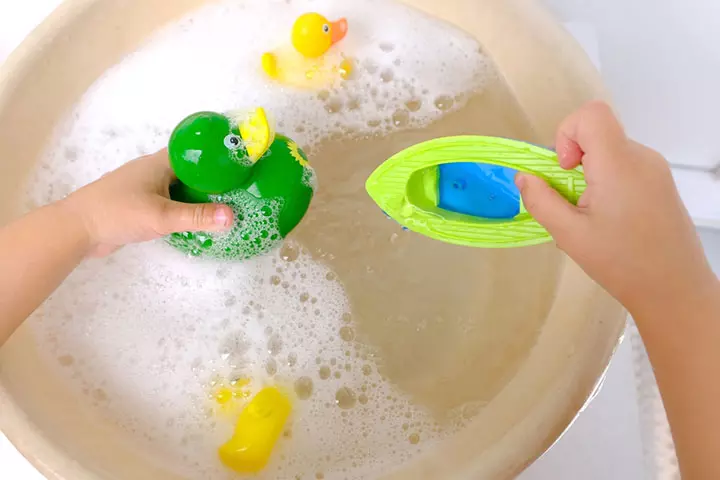
Image: Shutterstock
You may take the following precautions to protect your baby from the potential risks of mouthing.
- Keep babies away from choking hazards.
- Keep your baby under adult supervision so that they do not put harmful things in their mouth, especially outdoors.
- To maintain your child’s oral hygiene, clean all the toys and objects that the baby is likely to put in their mouth. Disinfecting the toys might help prevent infection in babies.
- Positive reinforcement can play a major role in weaning the baby off the habit. If your baby tends to mouth random objects, then substitute the harmful things with child-safe products and finger foods such as carrot and potato, if the baby is older than ten months.
- For verbal and older babies, encourage them to understand the meaning of “no.” Gently say no to them when they are putting things in their mouths.
- Teethers are a good choice for babies who are undergoing teething. Biting on these toys will keep the baby at ease and prevent them from putting harmful things in their mouth.
- Pacifiers might help in keeping the babies calm while they are in the mouthing phase. It may also facilitate taste exploration in babies. Use small loops to attach the pacifier to the baby’s sleeve so that they do not drop it frequently and contaminate it. Avoid hanging the pacifier to the baby’s neck to prevent strangulation.
- Keep all liquids and cosmetics like shampoo, phenyl, detergent, and lipsticks away from the baby’s reach to prevent your baby from swallowing any harmful substance.
- Keep the first aid box and the medicines away from the baby to avoid accidental ingestion of medicines.
 Point to consider
Point to considerFrequently Asked Questions
1. Is mouthing a sign of hunger?
No, mouthing is not necessarily a sign of hunger. It is a normal developmental stage that babies go through to explore their world and self-soothe (7).
2. Can mouthing be a sign of developmental delays?
No, putting objects in the mouth is a typical sign of However, not doing so, along with muscle stiffness or weakness and difficulty bringing objects to the mouth, could suggest delayed motor skills development (8).
3. Can mouthing be a sign of anxiety or stress in babies?
Chewing inedible objects such as clothing, pens, or toys can be a way for children to comfort themselves, indicating stress or anxiety. Seeking advice from a healthcare provider is recommended if concerned about a child’s anxiety (9).
4. Can mouthing behavior affect tooth development?
Yes, mouthing behavior can affect tooth development, particularly after the age of three years. Generally, there’s no tooth damage, but this habit may potentially affect permanent teeth (10).
5. Can mouthing be a sign of sensory processing disorder?
Babies and infants often use mouthing for oral stimulation or to self-soothe or explore their environment, which is normal. Therefore, it may not indicate a sensory processing disorder. However, if this continues past the typical age or becomes disruptive, it’s wise to consult a healthcare professional for an assessment of any underlying issues (11).
6. Can mouthing behavior be a sign of autism spectrum disorder in babies?
A study noted that babies at risk of autism might show less mouthing when younger than 12 months and more at around 15 months than typically developing babies. This correlation calls for further investigation, as the study did not establish a definitive causal link (12). Speak to a pediatrician for further assessment if you wish to have your baby screened for autism.
Mouthing in babies is a common and natural behavior that should not cause any concern as it would likely go away after they reach a certain age. Babies tend to often put things in their mouth during the teething phase or as part of their reflex. However, during mouthing in babies, you need to be careful about what they put in their mouths to prevent them from choking and contracting an infection. So, encourage pacifier use or give them a teether and follow the precautionary tips to ensure your baby’s safety.
Infographic: How To Keep Your Baby Safe During Their Mouthing Phase
Once your baby starts crawling, one of the significant challenges parents face is preventing them from putting random things into their mouth. As a parent, you want to ensure your baby stays safe and healthy during their mouthing phase. Check out the infographic below to learn how to ensure baby safety during this stage.

Illustration: Momjunction Design Team
Illustration: Mouthing In Babies: Why They Do And When To Stop It

Image: Stable Diffusion/MomJunction Design Team
Babies and toddlers often tend to put everything within their graph in their mouths, which can be dangerous at times. Help your toddler break this habit with these simple tips!
Personal Experience: Source
MomJunction articles include first-hand experiences to provide you with better insights through real-life narratives. Here are the sources of personal accounts referenced in this article.
ⅰ. Why do babies and young toddlers put everything in their mouth and what can we learn from it?https://montessorijourneyblog.wordpress.com/2018/05/24/why-do-babies-and-young-toddlers-put-everything-in-their-mouth-and-what-can-we-learn-from-it/
References
1. Mary K. Fagan and Jana M. Iverson, The Influence of Mouthing on Infant Vocalization; U.S. National Library of Medicine
2. Infant reflexes; U.S. National Library of Medicine
3. Symptoms Associated With Infant Teething: A Prospective Study; OFFICIAL JOURNAL OF THE AMERICAN ACADEMY OF PEDIATRICS
4. An Observational Study of Object Mouthing Behavior by Young Children; OFFICIAL JOURNAL OF THE AMERICAN ACADEMY OF PEDIATRICS
5. Orlando Tanaka et al, Breaking the Thumb Sucking Habit: When Compliance Is Essential; The Journal Of Case Reports In Dentistry
6. Farah Abdulsatar et al, Teething necklaces and bracelets pose significant danger to infants and toddlers; Oxford Academic Paediatrics & Child Health
7. What’s Mouthing and its Role in Feeding; Healthy Kids
8. Developmental Delays; Beaumont Children’s
9. Why Do Kids Chew On Everything?; Pathways
10. Dental: Teeth and Gum Care for Infants and Toddlers; Nationwide Children’s Hospital
11. Oral Sensory Seeking: Information, Strategies & Activities; Ready Kids Occupational Therapy
12. Maninderjit Kaur et al, Atypical object exploration in infants at-risk for autism during the first year of lifer; PMC
Community Experiences
Join the conversation and become a part of our nurturing community! Share your stories, experiences, and insights to connect with fellow parents.
Read full bio of Dr. Umera Zakiahmed Saiyed
Read full bio of Dr. Ritika Shah
Read full bio of Swati Patwal
Read full bio of Anindita Ghatak










